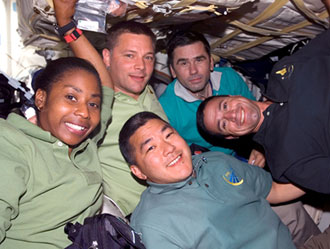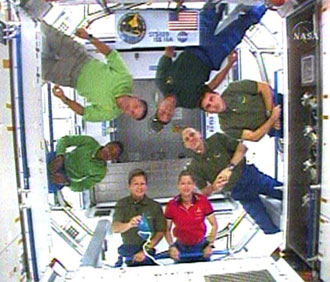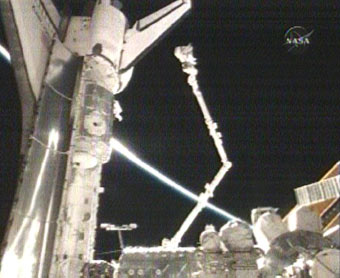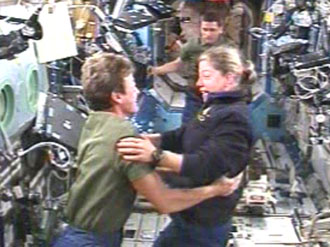STS-120
Report #13
12:45 a.m. CDT Monday, October 29, 2007
Mission Control Center, Houston, Texas
HOUSTON – With two successful spacewalks completed in three days, the crews on Space Shuttle Discovery and the International Space Station have some time to relax today while also completing a big handoff and getting prepared for another EVA on Tuesday.
This morning’s wakeup music at 11:39 p.m., “One by One” by Wynton Marsalis, was played for Mission Specialist Stephanie Wilson, one of the robot arm operators for this morning’s hand off of the P6 truss element between the shuttle and station robot arms.
P6, which was removed from the station during Sunday’s spacewalk, spent the night in a parked position in the grip of Canadarm2, which is based on the station’s Mobile Base System. At 2:08 a.m. CDT Wilson and Pilot George Zamka will fly the shuttle robot arm to grapple P6. Mission Specialist Clay Anderson and Flight Engineer Dan Tani will command the station arm to let go and then they will position the arm for a ride across the station’s truss.
At 4:23 a.m. the Mobile Transporter will begin a 90-minute transit to work site 8, the last stop on the port end of the station’s truss. Once the railcar locks down there, Anderson and Tani will reach out with Canadarm2 and take P6 back from the shuttle arm. It will be held there overnight and then installed on the port end of the truss during the mission’s third spacewalk Tuesday morning.
In between the two handoffs the crews are scheduled for off duty time. After lunch Tani and space station Commander Peggy Whitson will begin outfitting the avionics rack in the Harmony node while Mission Specialist Paolo Nespoli helps spacewalkers Scott Parazynski and Doug Wheelock prepare the airlock for the next spacewalk.
At 12:43 p.m. shuttle Commander Pam Melroy, Wilson and Anderson will join Whitson, Tani and Flight Engineer Yuri Malenchenko in the Harmony node to talk about the progress of the flight with ABC News, NBC News and CNN News.
The station and space shuttle flight control teams and mission managers are discussing options following the discovery by Tani during yesterday’s spacewalk of particulate matter (of unknown composition) inside the station’s starboard Solar Alpha Rotary Joint. That joint has been experiencing increased friction during rotation for the past month and a half. Station managers have decided to limit the use of the SARJ while the situation is assessed.
The next STS-120 status report will be issued Monday afternoon or earlier if events warrant.






